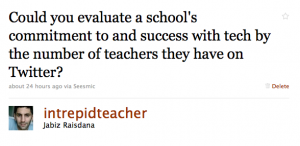A few days ago, I sent out a Tweet asking:
I thought of the idea after I saw the “dream team” that is being assembled at various international schools world wide. I noticed that several people I follow and trust as great members of my team have ended up at Korean International School @stevekatz @krea_frobro747 @kurisuteen and @tsbray I was quickly told that @b_roadside is at KIS as well. Last year there was the All-Star team in Bangkok. Are there others?
For those of you familiar with this sports analogy, you will appreciate that teams who want to create a unified team will scour the free agent market and find players who will help deliver them a championship. Is your team looking for a connected team?
I thought about the teachers I know world wide who Tweet and are connected through various modes of networking tools. I thought about where they are placed and whether or not they feel isolated or connected. I was jealous of the people at KIS, because they seem to have a great team who shared similar values regarding pedagogy and technology.
I thought about how I was excited to now be at a school with at least one other person on Twitter @janeinjava, but this constant connection and interaction is not the culture of my school. (Not yet) I am hoping that I too can create an environment where we have a team on Twitter soon, and I am hoping that doesn’t only mean that they randomly tweet now and then, but rather the team reflects a culture of connectivity.
But one can look at KIS now, and see that they value technology and it’s implications in education, based on their recruiting practice. I have a feeling that this team was created partly through luck and happenstance, or is it because they are purposefully recruiting teachers who are connected? You tell me. How many schools during interviewing ask potential teachers whether they are on Twitter, or how they use social networks to stay tuned to the latest professional development?
Most people responded that they did not feel that the number of Tweeting teachers had any correlation to a schools commitment to technology, because many people simply use Twitter to waste time. I thought it was implied in my message that I meant teachers who are part of this burgeoning edtech community.
I am not claiming that a school should be judged solely on the number of tweeting teachers, but I do think that if you are in a school where there is a value placed on your involvement in social networks you should feel lucky.
Where do you teach? Are you looked at like some kind of geek because you Tweet or blog, or is there a culture of these activities at your school? What are some dream teams that you know of?



